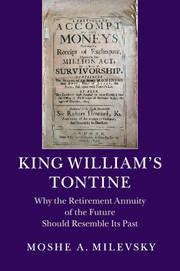Book contents
- Frontmatter
- Epigraph
- Contents
- Preface: In Memoriam for Jared
- Acknowledgments
- 1 King Billy, Protestant Hero of england
- 2 Tontine's Economic Origins: Cheaper Debt
- 3 A Most Curious Will(iam) and Older Than You Think
- 4 The Million Act to Fight a War against France
- 5 Don't Englishmen Die? Anti-Selection vs. Fraud
- 6 Is Your Tontine a Stock or a Bond?
- 7 Optimal Tontine: Hedging (Some) Longevity Risk
- 8 Conclusion: Tontines for the Twenty-First Century
- Epilogue: What Did William Really Know?
- Appendix A The List of Nominees
- Appendix B The Gompertz-Makeham Law of Mortality
- Appendix C 14% for One, 12% for Two, or 10% for Three?
- Source Notes and Guide to Further Reading
- References
- Index
6 - Is Your Tontine a Stock or a Bond?
Published online by Cambridge University Press: 05 May 2015
- Frontmatter
- Epigraph
- Contents
- Preface: In Memoriam for Jared
- Acknowledgments
- 1 King Billy, Protestant Hero of england
- 2 Tontine's Economic Origins: Cheaper Debt
- 3 A Most Curious Will(iam) and Older Than You Think
- 4 The Million Act to Fight a War against France
- 5 Don't Englishmen Die? Anti-Selection vs. Fraud
- 6 Is Your Tontine a Stock or a Bond?
- 7 Optimal Tontine: Hedging (Some) Longevity Risk
- 8 Conclusion: Tontines for the Twenty-First Century
- Epilogue: What Did William Really Know?
- Appendix A The List of Nominees
- Appendix B The Gompertz-Makeham Law of Mortality
- Appendix C 14% for One, 12% for Two, or 10% for Three?
- Source Notes and Guide to Further Reading
- References
- Index
Summary
BUILDING FINANCIAL BRIDGES
The tontine of King William – as well as the subsequent one launched in 1789 – was debt financing, pure and simple. The tontines issued in France and the Netherlands were also debt. But recall from your Finance 101 lectures, there are other ways to finance a business, and, indeed, tontines could be used as equity financing, as well.
One of the first examples of tontine equity (i.e., not bond) financing was used to build a bridge 50 miles to the east of the City of London in the northern coast of Kent in the year 1774. For this tontine, a total of £24,000 was raised through 2,000 shares of £12 each. Dividends were paid quarterly, but the nominee had to be alive at the last day of the quarter. Of the entire amount (£24,000) raised and not used in completing the bridge, the balance was kept to repair the bridge and amend roads. Shares were canceled upon the death of a nominee. Once the 2,000 shares had been reduced by 75% to 500 (shares, nominees), the holders of the shares became proprietors of the bridge and tolls, and the shares continued as bona fide property, which was transferrable. The bridge was known as the Tontine Bridge, and the dividends came from the tolls of those who used the bridge.
The Glasgow Tontine Society
Another interesting example of a tontine share structure that was used as a method of corporate financing – as opposed to government financing – was the Glasgow Tontine Society, which will soon be celebrating its 200-year anniversary. This particular scheme was launched in 1816 with a contributed capital of £20,000 shares of £25 each – a sum worth approximately thirty times as much in 2015 after inflation is accounted for – which was divided into 800 shares. This tontine was very successful with 100% of shares subscribed by 158 different investors (aka proprietors) acquiring an average of five shares each.
- Type
- Chapter
- Information
- King William's TontineWhy the Retirement Annuity of the Future Should Resemble its Past, pp. 114 - 139Publisher: Cambridge University PressPrint publication year: 2015



